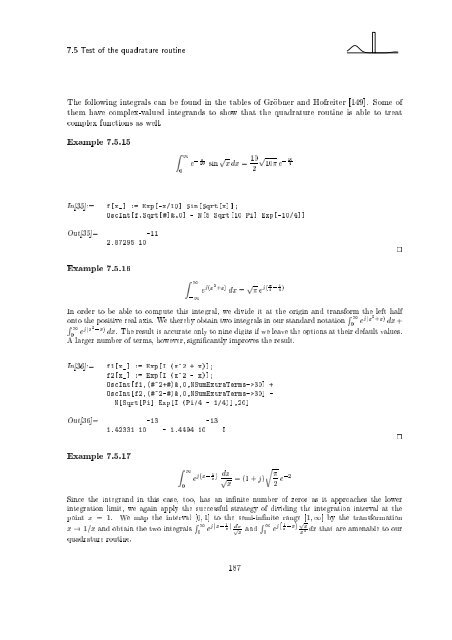Wave Propagation in Linear Media | re-examined
Wave Propagation in Linear Media | re-examined
Wave Propagation in Linear Media | re-examined
Create successful ePaper yourself
Turn your PDF publications into a flip-book with our unique Google optimized e-Paper software.
7.5 Test of the quadratu<strong>re</strong> rout<strong>in</strong>e<br />
The follow<strong>in</strong>g <strong>in</strong>tegrals can be found <strong>in</strong> the tables of Grobner and Hof<strong>re</strong>iter [149]. Some of<br />
them have complex-valued <strong>in</strong>tegrands to show that the quadratu<strong>re</strong> rout<strong>in</strong>e is able to t<strong>re</strong>at<br />
complex functions as well.<br />
Example 7.5.15<br />
Z 1<br />
0<br />
x ,<br />
e 10 s<strong>in</strong> p xdx = 10<br />
2<br />
p 10 e , 10 4<br />
In[35]:= f[x_] := Exp[-x/10] S<strong>in</strong>[Sqrt[x]];<br />
OscInt[f,Sqrt[#]&,0] - N[5 Sqrt[10 Pi] Exp[-10/4]]<br />
Out[35]= -11<br />
2.87295 10<br />
Example 7.5.16<br />
Z 1<br />
,1<br />
e j(x2 +x) dx = p e j( 4 , 1 4 )<br />
In order to be able to compute this <strong>in</strong>tegral, we divide it at the orig<strong>in</strong> and transform the left half<br />
onto the positive <strong>re</strong>al axis. We the<strong>re</strong>by obta<strong>in</strong> two <strong>in</strong>tegrals <strong>in</strong> our standard notation R 1<br />
0 ej(x2 +x) dx +<br />
R 1<br />
0 ej(x2 ,x) dx. The <strong>re</strong>sult is accurate only to n<strong>in</strong>e digits if we leave the options at their default values.<br />
A larger number of terms, however, signi cantly improves the <strong>re</strong>sult.<br />
In[36]:= f1[x_] := Exp[I (x^2 + x)];<br />
f2[x_] := Exp[I (x^2 - x)];<br />
OscInt[f1,(#^2+#)&,0,NSumExtraTerms->30] +<br />
OscInt[f2,(#^2-#)&,0,NSumExtraTerms->30] -<br />
N[Sqrt[Pi] Exp[I (Pi/4 - 1/4)],20]<br />
Out[36]= -13 -13<br />
1.42331 10 - 1.4494 10 I<br />
Example 7.5.17<br />
Z 1<br />
0<br />
1 j(x,<br />
e x ) dx<br />
r<br />
p =(1+j)<br />
x 2 e,2<br />
S<strong>in</strong>ce the <strong>in</strong>tegrand <strong>in</strong> this case, too, has an <strong>in</strong> nite number of zeros as it approaches the lower<br />
<strong>in</strong>tegration limit, we aga<strong>in</strong> apply the successful strategy of divid<strong>in</strong>g the <strong>in</strong>tegration <strong>in</strong>terval at the<br />
po<strong>in</strong>t x = 1. We map the <strong>in</strong>terval [0; 1] to the semi-<strong>in</strong> nite range [1; 1[ by the transformation<br />
x ! 1=x and obta<strong>in</strong> the two <strong>in</strong>tegrals R 1<br />
0 ej(x, 1 x ) dx<br />
px and R 1<br />
0 ej( 1 x ,x) p x<br />
x 2 dx that a<strong>re</strong> amenable to our<br />
quadratu<strong>re</strong> rout<strong>in</strong>e.<br />
187












